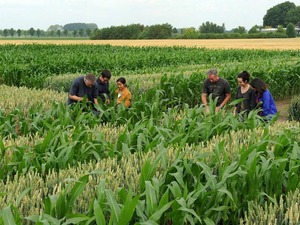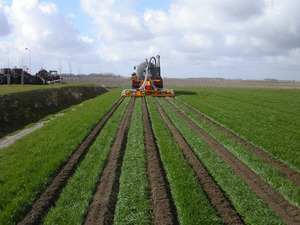Case study 1: The Netherlands: Breaking maize monoculture
Cluster 1: Service crops
Dairy farming is an important agricultural sector in the Netherlands covering about 65% of the total agricultural area. Dominant feed crops are grass and silage maize. Most silage maize is grown in continuous monocultures on the same field. This is mostly done for practical and economic reasons. Maize is a highly productive feed crop that combines well with grass. This combination has been optimised for decades. It is more convenient to have the grass close to the farm for grazing the cows and because grass is harvested more frequently than maize. The fields at greater distance are thus left to Maize.
What were the main problems underlying the emergence of the case study?
The cultivation of maize as a monocrop has led to adverse side effects. The soil quality has decreased due to relatively low organic matter supply and the use of heavy machinery for harvest. Together with the increased pressure of soil-borne diseases and weed problems this limits crop production. Additionally, nitrate leaching on maize fields is exceeding acceptable levels. Furthermore, the dairy sector has been challenged to decrease greenhouse gas and ammonia emissions and to become more self-sufficient for feed protein production. Therefore, a transition to sustainable feed production systems is necessary.
Moreover, the higher chance of drought or floods due to climate change and expected limitations in the application of pesticides may affect maize production in the long term. Although the problem is not new, the farmers’ awareness has increased as they are becoming less self-sufficient and more dependent on imported and expensive feeds. This has a clear and negative impact on their economic performance.
Societal demands for sustainable production, the reduction of pesticide use, limited nitrate emissions, attractive landscape and sustainable water management present a need to break the maize monoculture and diversify feed production. This was the focus of the case study.
How was the problem addressed and which actors were involved?
Different options for innovative and sustainable maize cropping systems were identified and developed. The challenge for this case study was to support the main actors to realize diversified systems for feed production, which balance investments and benefit for farmers as well as society. Diversification in the form of integrating alternative feed crops, fodder service crops, or cereal/grain protein intercrops can potentially improve the feed production system. The main actors involved in this case study were private actors such as farmers, advisors, breeders, contractors, suppliers, dairy industry workers, researchers and public actors such as national and provincial governments and waterboards. Stakeholders were involved in analysing the problem and possible solutions. For each of the case study interventions, we assessed which stakeholders should be involved and in what way.
Solution investigated
The case study focused on two topics: alternative feed crops and rethinking feed production. To address these topics, the case study supported existing projects that focus on sustainable feed production. This support aimed to increase the effectiveness of the projects through activities such as participatory problem analysis and action planning, facilitating discussion among stakeholders along the value chain and field demonstrations of alternative cropping systems. Our activities aimed, on the one hand, to increase the awareness of the stakeholders that influence feed production and, on the other hand, to stimulate the development and implementation of sustainable feed production systems as alternatives to monoculture.
Over the years we have seen that there is a higher interest among farmers to diversify their maize cropping systems. In the last year of the project, we investigated the reasons behind this: Why are farmers starting to implement more diversified maize cropping systems and how do they feel about it? The predominant intercrop is maize and beans and this is used as a means to increase the protein content in the fodder harvest. So far, the results vary quite a lot between years and sites; farmers are experimenting with different varieties to get more stable results.
Expected outcome
The different interventions from this case study, in collaboration with the associated projects, contributed to increased awareness, increased insight in the alternatives and improved support for farmers who want to diversify their feed production. Furthermore, the case study indirectly contributed to the implementation of more diversified feed production systems on dairy farms in the Netherlands, amongst others, by exploring the motives of farmers to do so.
Relevance for the DiverIMPACTS goals?
This will contribute to diversified agricultural production in general, as the dairy sector covers the majority of the agricultural area in the Netherlands. Thus, this case study contributes to exploring and realizing the potential of diversification to achieve sustainable agriculture.
Case study legacy
The case study itself will not directly continue, but the experiences and the momentum created in the case study will be used in other projects on maize cultivation, sustainable soil management and climate change, just as previous projects have enriched the case study. We experienced that innovative maize growers are more and more interested in diversifying their maize crop because they expect benefits for themselves as well, for example a higher protein content in their fodder if maize is mixed with a legume. These farmers find us for answers to their questions on how to execute this.
Further information
Case study team
- Marie Wesselink, Wageningen University & Research, case study leader
- Jorieke Potters, Wageningen University & Research, case study monitor


 tap and then scroll down to the Add to Home Screen command.
tap and then scroll down to the Add to Home Screen command.